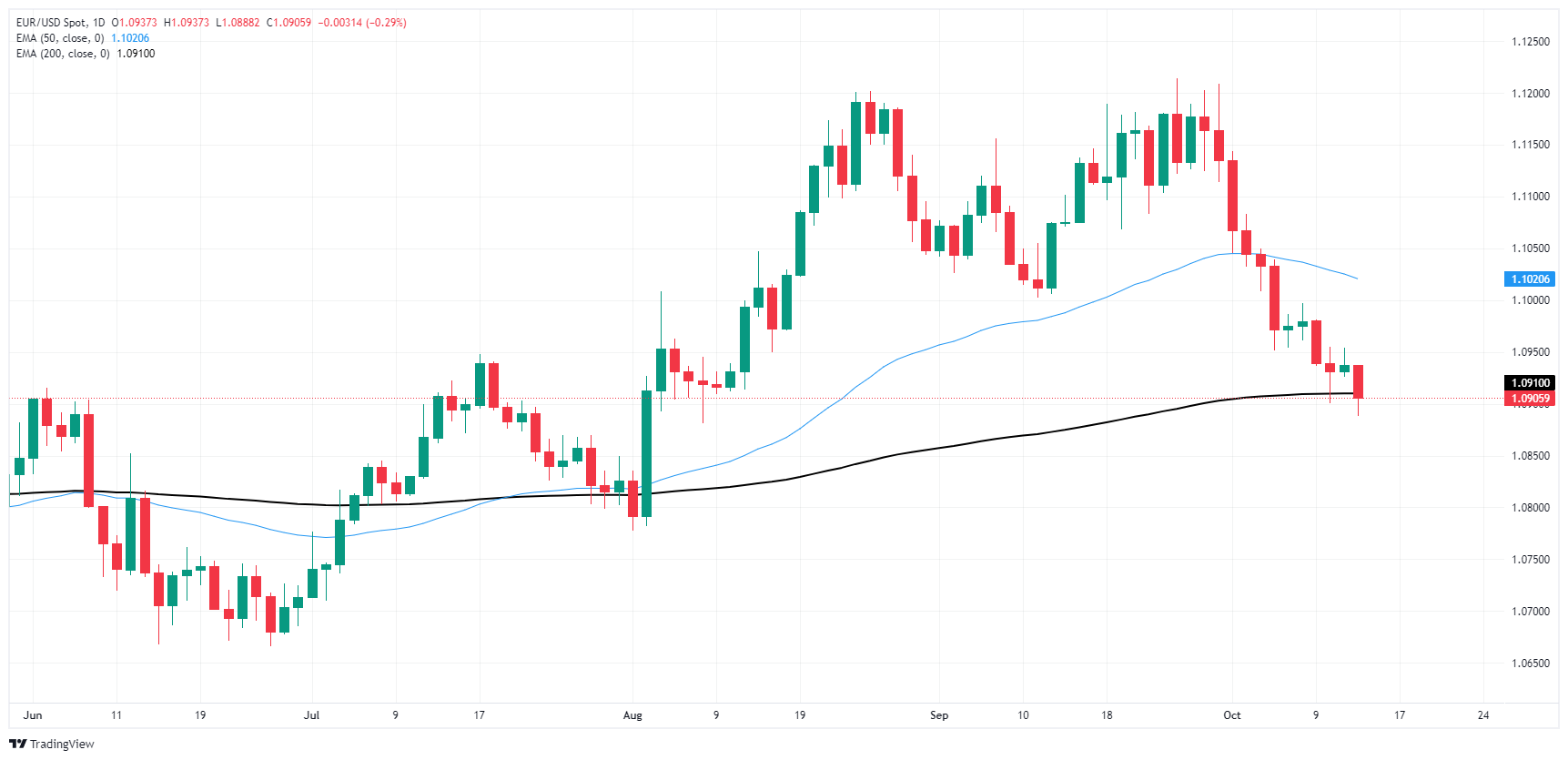- EUR/USD is set to fall for the third consecutive week against the Dollar.
- The pair started the new trading week by finding new lows as confidence in the Euro wanes.
- The ECB is expected to cut rates by another 25 bps this week.
EUR/USD hit a new ten-week low on Monday, starting a new trading week with renewed declines. The Euro lost a quarter of a percent against the Dollar, touching the 200-day EMA as USD strength combines with a broadly weakened EUR.
The latest results from the European Central Bank’s (ECB) Lending Survey are expected early Tuesday, and investors will be looking for any clues about the overall health of the pan-European banking sector this week.
Europe’s final Harmonized Index of Consumer Prices (HICP) inflation figures will be released early Thursday, but are unlikely to generate much volatility as markets keep an eye on the widely expected European Central Bank (ECB). to cut interest rates by 25 basis points, also on Thursday.
Significant US data is not expected until Thursday’s US Retail Sales, which is expected to accelerate to 0.3% m/m in September after August’s lackluster 0.1%.
EUR/USD Price Forecast
EUR/USD is succumbing to clear bearish pressure, with the pair falling to the 200-day EMA and retreating to the 1.0900 area at the same time. The pair has fallen almost 3% top to bottom from late September peaks just above 1.1200, and the pair has closed in the red in all but four of the last 13 consecutive trading days.
Price action around the 200-day EMA will be critical in determining the near-term direction of EUR/USD. A sustained break below this level could open the door for further declines, with the next support zone seen around the 1.0850 level. On the other hand, if the pair manages to reclaim the 200-day EMA and move above 1.09063, it could alleviate some of the immediate bearish pressure. However, the 50-day EMA remains a key resistance level that needs to be overcome for any sustained bullish reversal.
The technical outlook remains bearish as long as the pair remains below the 50-day EMA. Although the 200-day EMA at 1.09063 may provide some temporary support, the current trend suggests continued downside risks in the near term. The lack of a strong bullish catalyst means the pair could remain under pressure, and traders will be on the lookout for further signs of weakness, especially if the pair remains below the key moving averages.
EUR/USD Daily Chart
The Euro FAQs
The Euro is the currency of the 20 countries of the European Union that belong to the euro zone. It is the second most traded currency in the world, behind the US dollar. In 2022, it accounted for 31% of all foreign exchange transactions, with an average daily volume of more than $2.2 trillion per day. EUR/USD is the most traded currency pair in the world, accounting for an estimated 30% of all transactions, followed by EUR/JPY (4%), EUR/GBP (3%) and EUR/AUD (2% ).
The European Central Bank (ECB), headquartered in Frankfurt, Germany, is the reserve bank of the euro zone. The ECB sets interest rates and manages monetary policy The ECB’s main mandate is to maintain price stability, which means controlling inflation or stimulating growth. Its main instrument is to raise or lower interest rates. Relatively high interest rates – or the expectation of higher rates – tend to benefit the Euro and vice versa. The Governing Council of the ECB takes monetary policy decisions at meetings held eight times a year. Decisions are made by the heads of the eurozone’s national banks and six permanent members, including ECB President Christine Lagarde.
Eurozone inflation data, measured by the Harmonized Index of Consumer Prices (HICP), are an important econometric data for the euro. If inflation rises more than expected, especially if it exceeds the 2% target set by the ECB, it is forced to raise interest rates to bring it back under control. Relatively high interest rates compared to their peers tend to benefit the Euro, as it makes the region more attractive as a place for global investors to park their money.
Data releases measure the health of the economy and can influence the Euro. Indicators such as GDP, manufacturing and services PMIs, employment and consumer sentiment surveys can influence the direction of the single currency. A strong economy is good for the Euro. Not only does it attract more foreign investment, but it may encourage the ECB to raise interest rates, which will directly strengthen the Euro. Conversely, if economic data is weak, the Euro is likely to fall. The economic data for the four largest economies in the eurozone (Germany, France, Italy and Spain) are especially significant, as they represent 75% of the eurozone economy.
Another important release for the euro is the trade balance. This indicator measures the difference between what a country earns from its exports and what it spends on imports during a given period. If a country produces highly sought-after export products, its currency will appreciate due to the additional demand created by foreign buyers wishing to purchase these goods. Therefore, a positive net trade balance strengthens a currency and vice versa for a negative balance.
Source: Fx Street
I am Joshua Winder, a senior-level journalist and editor at World Stock Market. I specialize in covering news related to the stock market and economic trends. With more than 8 years of experience in this field, I have become an expert in financial reporting.







